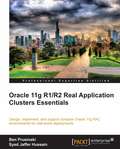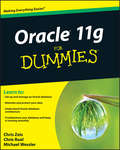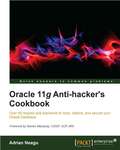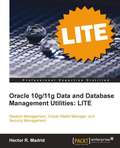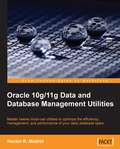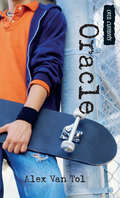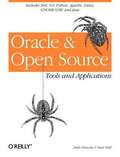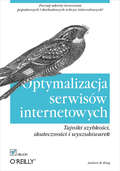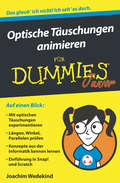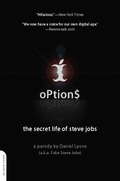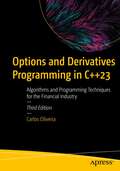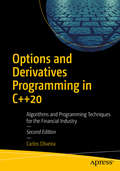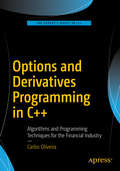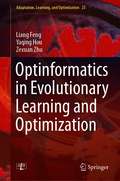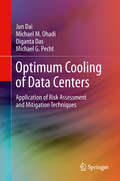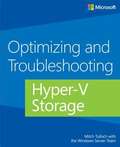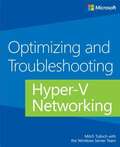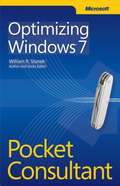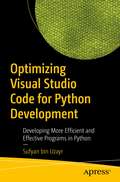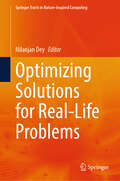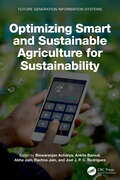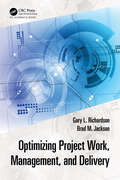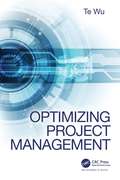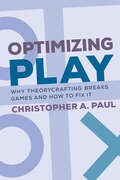- Table View
- List View
Oracle 11g R1/R2 Real Application Clusters Essentials
by Ben Prusinski Syed Jaffer HussainThis book documents how to administer a complex Oracle 11g RAC environment. It covers new RAC components such as ASM's new features, performance tuning, and troubleshooting. It contains real world examples, expert tips, and troubleshooting advice. This book focuses on Oracle RAC 11g R1 with additional 11g R2 information included. If you are an Oracle DBA who wants to administer Real Application Clusters, then this book is for you. Basic understanding of Oracle DBA is required. No experience of Oracle RAC is required.
Oracle 11g For Dummies
by Chris Ruel Chris Zeis WesslerAre you a seasoned system administrator charged with setting up an Oracle database? Or did you suddenly become a DBA by default? If database administration with Oracle is part of your job, you'll be glad to have Oracle 11g For Dummies in your cubicle.This nuts-and-bolts guide walks you through the mysteries of Oracle and database administration. You'll learn how to understand Oracle database architecture, set up and manage an Oracle database, and keep it running in tiptop form. Oracle 11g For Dummies covers:The building blocks behind the database engine as well as Oracle's physical and logical structuresHardware, software, system, and storage requirements for implementationHow to recognize and accommodate the differences between Oracle installations on Windows and on Linux/UNIXDaily and intermittent tasks necessary to keep your database running properlyHow to assess potential threats to your database, configure Oracle Recovery Manager, and set up backup and recovery proceduresWhen to use online, offline, controlfile, and archivelog backupsTroubleshooting methodology and how to use Oracle database logs and other diagnostic utilitiesDifferent ways to manage your databaseHow to automate jobs with the Oracle SchedulerUsing SQL in Oracle, and a great deal moreCompletely up to date for the newest release of Oracle, Oracle 11g For Dummies will give you both the information and the confidence to set up and maintain an Oracle database for your organization.
Oracle 11g Anti-hacker's Cookbook
by Adrian NeaguThis cookbook has recipes written in simple, easy to understand format with lots of screenshots and insightful tips and hints. If you are an Oracle Database Administrator, Security Manager or Security Auditor looking to secure the Oracle Database or prevent it from being hacked, then this book is for you. This book assumes you have a basic understanding of security concepts.
Oracle 10g/11g Data and Database Management Utilities: LITE
by Hector R. MadridThis practical, hands-on book is specifically designed to improve the way you use and work with Oracle database utilities. The material has been carefully selected from Packt's fuller Oracle 10g/11g Data and Database Management Utilities title. The full edition of the book covers a number of additional utilities including Data Pump, SQL*Loader, Recover Manager, and more! This book is aimed at all Oracle professionals who interact with the database through the data and database utilities and are willing to optimize their interaction with it.
Oracle 10g/11g Data and Database Management Utilities
by Hector R. MadridThis book is written using a practical approach that guides you through different practical scenarios. It provides a brief introduction to the topics; this way you can quickly get to know the main features, start being productive with the tool, and grow with it at a fast pace. You won't have to spend too much time getting to the basics of the tool and can immediately progress towards the advanced tips. Using this practical approach you don't have to spend valuable time trying to decipher arid reference manuals; you can easily set up the practical scenarios, and try to follow up the presentations. The images used in the book come from real scenarios, and the output is always explained so you can easily interpret what is being displayed on the screen after issuing the commands. This book is aimed at all Oracle professionals who interact with the database through the data and database utilities and are willing to optimize their interaction with it. Entry-level users will get acquainted with the best practices to get their job done in a timely and efficient manner. Advanced users will find useful tips and How-Tos that will help them focus on getting the most out of the database utilities and fine-tune batch processing.
Oracle (Orca Currents)
by Alex Van TolOwen has a crush on Kamryn. Kamryn has a crush on Owen's brother Kyle. Owen knows extreme action is necessary to make sure Kamryn does not end up dating his brother, a jerk who manipulates every situation to get what he wants. So what does Owen do? He manipulates the situation. With the help of his friend Hannah, Owen sets up a blog called The Oracle that gives out relationship advice to local teens. Everything seems to be going great. Hannah and Owen are having fun, and Kamryn seems to be following The Oracle's advice and taking an interest in Owen. Owen thinks he's got it made, but he soon discovers that fraudulent tactics have their consequences.
Oracle & Open Source
by Andy Duncan Sean HullOracle and Open Source is the first book to tie together the commercial world of Oracle and the free-wheeling world of open source software. As this book reveals, these two worlds are not as far apart as they may seem. Today, there are many excellent and freely available software tools that Oracle developers and database administrators can use, at no cost, to improve their own coding productivity and their system's performance. Moreover, many of the finest Oracle developers are now making their source code freely available so their peers can build upon this code base. Oracle Corporation is even porting its RDBMS to Linux and starting to incorporate a growing number of open source tools in the company's own software. Oracle and Open Source describes close to 100 open source tools you can use for Oracle development and database administration, from large and widely known open source systems (like Linux, Perl, Apache, TCL/Tk and Python) to more Oracle-specific tools (like Orasoft, Orac, OracleTool, and OraSnap). You'll learn how to obtain the software and how to adapt it to best advantage. The book abounds with code examples, download and installation instructions, and helpful usage hints. Not only does it tell you how to find and use existing open source code; Oracle and Open Source gives you the details and the motivation to build your own open source contributions and release them to the Oracle community. You'll learn all about tools like the Oracle Call Interface (OCI) and Perl-DBI (Database Interface), which provide the glue allowing new open source tools to link into commercial Oracle software. With Oracle and Open Source as a guide, you'll discover an enormous number of highly effective open source tools, while getting involved with the thriving community of open source development.
Optymalizacja serwisów internetowych. Tajniki szybko?ci, skuteczno?ci i wyszukiwarek
by Andrew B. KingPoznaj sekrety tworzenia popularnych i dochodowych witryn internetowych! Jak poprawi? widoczno?? serwisu w wyszukiwarkach?Jak zoptymalizowa? p?atne kampanie reklamowe?Jak odnie?? sukces w Internecie?Celem optymalizacji witryny WWW jest przede wszystkim maksymalizacja przychodów z serwisu i podniesienie komfortu u?ytkowników. Aby ten cel osi?gn??, trzeba spe?ni? kilka podstawowych warunków. Po pierwsze nale?y zadba? o to, aby serwis mo?na by?o ?atwo odszuka? w sieci. Po drugie korzystanie z niego nie mo?e sprawia? trudno?ci, a po trzecie powinien on by? szybki, atrakcyjny i interaktywny. Krótko mówi?c, dobry serwis musi by? funkcjonalny i wydajny. Aby osi?gn?? sukces w sieci, nale?y zatem wybra? w?a?ciwe metody i przyj?? skuteczn? strategi? dzia?ania. Jakie to techniki i jak je stosowa?, dowiesz si? w?a?nie z tej ksi??ki.Ksi??ka "Optymalizacja serwisów internetowych. Tajniki szybko?ci, skuteczno?ci i wyszukiwarek" wska?e Ci mo?liwo?ci tworzenia i optymalizacji serwisu internetowego, pozwalaj?ce w znacznym stopniu ograniczy? inwestycje w marketing, a jednocze?nie zyska? wielu klientów. Z tego podr?cznika dowiesz si?, jak zoptymalizowa? serwis pod k?tem wyszukiwarek, na czym polega w?a?ciwy dobór s?ów kluczowych, jak zbudowa? architektur? CSS i tworzy? ciekawe rozwi?zania, opieraj?ce si? na Ajaksie. Ponadto nauczysz si? optymalizowa? kampanie reklamowe dzi?ki stosowaniu perswazyjnej tre?ci reklam. Po tej lekturze b?dziesz umia? stworzy? wydajny, funkcjonalny, a przy tym popularny i dobrze zarabiaj?cy serwis internetowy. Optymalizacja pozycji serwisu w wyszukiwarkachNarz?dzia do analizowania s?ów kluczowychNag?ówki przyci?gaj?ce uwag?Optymalizacja reklam p?atnych (PPC)Dobór grupy docelowej i kwalifikowanie odwiedzaj?cychWykorzystanie metryk do ustalenia bud?etuOptymalizacja wspó?czynnika konwersjivOptymalizacja stron WWWBudowanie architektury CSSTworzenie w?asnych rozwi?za?, opartych na AjaksieZaawansowana optymalizacja serwisów WWWMetryki optymalizacji wydajno?ciOptymalizuj serwis i dochody!
Optische Täuschungen animieren für Dummies Junior (Für Dummies)
by Joachim WedekindDu wirst deinen Augen nicht mehr trauen. Dieses Buch enthält einige bekannte und weniger bekannte optische Täuschungen: Quadrate rutschen, die gar nicht rutschen dürften, Linien springen, die gar nicht springen dürften. Du siehst kurze und lange Linien, obwohl alle Linien gleich lang sind. Und das Beste ist: Du kannst diese optischen Täuschungen mit der Programmiersprache Snap! selber erzeugen. Und dann kannst du alle Eigenschaften verändern. Spiele mit den Abständen der Linien, ihrer Dicke und Farbe und vielem anderen mehr und überprüfe, ob sich der optische Eindruck verändert. Bestens geeignet für Kinder und Jugendliche ab 10 Jahre.
Options: The Secret Life of Fake Steve Jobs
by Daniel LyonsWelcome to the mind—to the world—of Fake Steve Jobs. Fake Steve the counterintuitive management guru: “Obviously we can’t literally put our employees’ lives at risk. But we have to make them feel that way.” Fake Steve the celebrity hobnobber: “I like Bono. He’s the only person I know who’s more self-absorbed than I am.”
Options and Derivatives Programming in C++23: Algorithms and Programming Techniques for the Financial Industry
by Carlos OliveiraThis book is a hands-on guide for programmers who want to learn how C++ is used to develop solutions for options and derivatives trading in the financial industry. It explores the main algorithms and programming techniques used in implementing systems and solutions for trading options and derivatives. This updated edition will bring forward new advances in C++ software language and libraries, with a particular focus on the new C++23 standard. The book starts by covering C++ language features that are frequently used to write financial software for options and derivatives. These features include the STL (standard template library), generic templates, functional programming, and support for numerical code. Examples include additional support for lambda functions with simplified syntax, improvements in automatic type detection for templates, custom literals, modules, constant expressions, and improved initialization strategies for C++ objects. This book also provides how-to examples that cover all the major tools and concepts used to build working solutions for quantitative finance. It discusses how to create bug-free and efficient applications, leveraging the knowledge of object-oriented and template-based programming. It has two new chapters covering backtesting option strategies and processing financial data.. It introduces the topics covered in the book in a logical and structured way, with lots of examples that will bring them to life. Options and Derivatives Programming in C++23 has been written with the goal of reaching readers who are looking for a concise, algorithms-based book that provides basic information through well-targeted examples and ready to use solutions. What You Will Learn Gain insight into the fundamental challenges of the options and derivatives marketMaster the features of the C++ language used in quantitative financial programmingUnderstand quantitative finance algorithms for options and derivativesBuild pricing algorithms around the Black-Scholes model, and use binomial and differential equations methods Who This Book Is For Professional developers who have some experience with the C++ language and would like to leverage that knowledge into financial software development.
Options and Derivatives Programming in C++20: Algorithms and Programming Techniques for the Financial Industry
by Carlos OliveiraMaster the features of C++ that are frequently used to write financial software for options and derivatives, including the STL, templates, functional programming, and numerical libraries. This book also covers new features introduced in C++20 and other recent standard releases: modules, concepts, spaceship operators, and smart pointers. You will explore how-to examples covering all the major tools and concepts used to build working solutions for quantitative finance. These include advanced C++ concepts as well as the basic building libraries used by modern C++ developers, such as the STL and Boost, while also leveraging knowledge of object-oriented and template-based programming. Options and Derivatives Programming in C++ provides a great value for readers who are trying to use their current programming knowledge in order to become proficient in the style of programming used in large banks, hedge funds, and other investment institutions. The topics covered in the book are introduced in a logical and structured way and even novice programmers will be able to absorb the most important topics and competencies. This book is written with the goal of reaching readers who need a concise, algorithms-based book, providing basic information through well-targeted examples and ready-to-use solutions. You will be able to directly apply the concepts and sample code to some of the most common problems faced in the analysis of options and derivative contracts. What You Will Learn Discover how C++ is used in the development of solutions for options and derivatives trading in the financial industry Grasp the fundamental problems in options and derivatives trading Converse intelligently about credit default swaps, Forex derivatives, and more Implement valuation models and trading strategies Build pricing algorithms around the Black-Sholes model, and also using the binomial and differential equations methods Run quantitative finance algorithms using linear algebra techniques Recognize and apply the most common design patterns used in options trading Who This Book Is For Professional developers who have some experience with the C++ language and would like to leverage that knowledge into financial software development.
Options and Derivatives Programming in C++
by Carlos OliveiraLearn how C++ is used in the development of solutions for options and derivatives trading in the financial industry. As an important part of the financial industry, options and derivatives trading has become increasingly sophisticated. Advanced trading techniques using financial derivatives have been used at banks, hedge funds, and pension funds. Because of stringent performance characteristics, most of these trading systems are developed using C++ as the main implementation language. Options and Derivatives Programming in C++ covers features that are frequently used to write financial software for options and derivatives, including the STL, templates, functional programming, and support for numerical libraries. New features introduced in the C++11 and C++14 standard are also covered: lambda functions, automatic type detection, custom literals, and improved initialization strategies for C++ objects. Readers will enjoy the how-to examples covering all the major tools and concepts used to build working solutions for quantitative finance. It includes advanced C++ concepts as well as the basic building libraries used by modern C++ developers, such as the STL and Boost, while also leveraging knowledge of object-oriented and template-based programming. Options and Derivatives Programming in C++ provides a great value for readers who are trying to use their current programming knowledge in order to become proficient in the style of programming used in large banks, hedge funds, and other investment institutions. The topics covered in the book are introduced in a logical and structured way and even novice programmers will be able to absorb the most important topics and competencies. What You Will Learn Grasp the fundamental problems in options and derivatives trading Converse intelligently about credit default swaps, Forex derivatives, and more Implement valuation models and trading strategies Build pricing algorithms around the Black-Sholes Model, and also using the Binomial and Differential Equations methods Run quantitative finance algorithms using linear algebra techniques Recognize and apply the most common design patterns used in options trading Save time by using the latest C++ features such as the STL and the Boost libraries Who This Book Is For Professional developers who have some experience with the C++ language and would like to leverage that knowledge into financial software development. This book is written with the goal of reaching readers who need a concise, algorithms-based book, providing basic information through well-targeted examples and ready to use solutions. Readers will be able to directly apply the concepts and sample code to some of the most common problems faced in the analysis of options and derivative contracts.
Optionen in der Energiewirtschaft (essentials)
by Stephan SchnorrOptionen sind seit jeher fester Bestandteil der Finanzmärkte, finden jedoch gleichwohl zunehmend Einsatz in der Energiewirtschaft. Das vorliegende essential verschafft einen Überblick über dieses Instrument und dessen Einsatz. Dazu wird das Instrument der Option unter anderem über die resultierenden Zahlungsströme sowie darauf aufbauend Einsatzmöglichkeiten von Optionen in der Energiewirtschaft beschrieben. Den Abschluss bildet ein Ausblick auf die Bewertung dieser Instrumente. Ein theoretischer Ansatz zur Bewertung wird kurz umrissen. Aus dem theoretischen Vorgehen lassen sich einige Ansätze ableiten, die in der Praxis weit verbreitet sind und hier ebenfalls kurz vorgestellt werden.
Optinformatics in Evolutionary Learning and Optimization (Adaptation, Learning, and Optimization #25)
by Liang Feng Yaqing Hou Zexuan ZhuThis book provides readers the recent algorithmic advances towards realizing the notion of optinformatics in evolutionary learning and optimization. The book also provides readers a variety of practical applications, including inter-domain learning in vehicle route planning, data-driven techniques for feature engineering in automated machine learning, as well as evolutionary transfer reinforcement learning. Through reading this book, the readers will understand the concept of optinformatics, recent research progresses in this direction, as well as particular algorithm designs and application of optinformatics. Evolutionary algorithms (EAs) are adaptive search approaches that take inspiration from the principles of natural selection and genetics. Due to their efficacy of global search and ease of usage, EAs have been widely deployed to address complex optimization problems occurring in a plethora of real-world domains, including image processing, automation of machine learning, neural architecture search, urban logistics planning, etc. Despite the success enjoyed by EAs, it is worth noting that most existing EA optimizers conduct the evolutionary search process from scratch, ignoring the data that may have been accumulated from different problems solved in the past. However, today, it is well established that real-world problems seldom exist in isolation, such that harnessing the available data from related problems could yield useful information for more efficient problem-solving. Therefore, in recent years, there is an increasing research trend in conducting knowledge learning and data processing along the course of an optimization process, with the goal of achieving accelerated search in conjunction with better solution quality. To this end, the term optinformatics has been coined in the literature as the incorporation of information processing and data mining (i.e., informatics) techniques into the optimization process. The primary market of this book is researchers from both academia and industry, who are working on computational intelligence methods and their applications. This book is also written to be used as a textbook for a postgraduate course in computational intelligence emphasizing methodologies at the intersection of optimization and machine learning.
Optimum Cooling of Data Centers
by Michael G. Pecht Jun Dai Michael M. Ohadi Diganta DasThis book describes the use of free air cooling to improve the efficiency of, and cooling of, equipment for use in telecom infrastructures. Discussed at length is the cooling of communication installation rooms such as data centers or base stations, and this is intended as a valuable tool for the people designing and manufacturing key parts of communication networks. This book provides an introduction to current cooling methods used for energy reduction, and also compares present cooling methods in use in the field. The qualification methods and standard reliability assessments are reviewed, and their inability to assess the risks of free air cooling is discussed. The method of identifying the risks associated with free air cooling on equipment performance and reliability is introduced. A novel method of assessment for free air cooling is also proposed that utilizes prognostics and health management (PHM). This book also: Describes how the implementation of free air cooling can save energy for cooling within the telecommunications infrastructure. Analyzes the potential risks and failures of mechanisms possible in the implementation of free air cooling, which benefits manufacturers and equipment designers. Presents prognostics-based assessments to identify and mitigate the risks of telecommunications equipment under free air cooling conditions, which can provide the early warning of equipment failures at operation stage without disturbing the data centers' service. Optimum Cooling for Data Centers is an ideal book for researchers and engineers interested in designing and manufacturing equipment for use in telecom infrastructures.
Optimizing and Troubleshooting Hyper-V Storage
by Mitch Tulloch The Windows Server TeamThis scenario-focused title provides concise technical guidance and insights for troubleshooting and optimizing storage with Hyper-V. Written by experienced virtualization professionals, this little book packs a lot of value into a few pages, offering a lean read with lots of real-world insights and best practices for Hyper-V storage optimization. Focused guide extends your knowledge and capabilities with Hyper-V storage in Windows Server 2012 Shares hands-on insights from a team of Microsoft virtualization experts Provides pragmatic troubleshooting and optimization guidance from the field
Optimizing and Troubleshooting Hyper-V Networking
by Mitch Tulloch The Windows Server TeamThis scenario-focused title provides concise technical guidance and insights for troubleshooting and optimizing networking with Hyper-V. Written by experienced virtualization professionals, this little book packs a lot of value into a few pages, offering a lean read with lots of real-world insights and best practices for Hyper-V networking optimization in Windows Server 2012. Focused guide extends your knowledge and capabilities with Hyper-V networking in Windows Server 2012 Shares hands-on insights from a team of Microsoft virtualization experts Provides pragmatic troubleshooting and optimization guidance from the field
Optimizing Windows® 7 Pocket Consultant
by William R. StanekPortable and precise, this pocket-sized guide delivers ready answers for optimizing the performance of your Windows 7-based PC. Zero in on core tuning, customization, and troubleshooting tasks using quick-reference tables, instructions, and lists. Topics include system boot and startup, software and hardware, search and indexing, system health, and personalizing the interface. You'll get the focused information you need to solve problems and get the job done.
Optimizing Visual Studio Code for Python Development: Developing More Efficient and Effective Programs in Python
by Sufyan bin UzayrLearn Visual Studio Code and implement its features in Python coding, debugging, linting, and overall project management. This book addresses custom scenarios for writing programs in Python frameworks, such as Django and Flask.The book starts with an introduction to Visual Studio Code followed by code editing in Python. Here, you will learn about the required extensions of Visual Studio Code to perform various functions such as linting and debugging in Python. Next, you will set up the environment and run your projects along with the support for Jupyter. You will also work with Python frameworks such as Django and go through data science specific-information and tutorials. Finally, you will learn how to integrate Azure for Python and how to use containers in Visual Studio Code.Optimizing Visual Studio Code for Python Development is your ticket to writing Python scripts with this versatile code editor.What You'll LearnExecute Flask development in Visual Studio Code for control over libraries used in an applicationOptimize Visual Studio Code to code faster and betterUnderstand linting and debugging Python code in Visual Studio CodeWork with Jupyter Notebooks in Visual Studio CodeWho This Book Is ForPython developers, beginners, and experts looking to master Visual Studio Code
Optimizing Solutions for Real-Life Problems (Springer Tracts in Nature-Inspired Computing)
by Nilanjan DeyThis book explores various optimization techniques that can be used to address problems in the real world. These problems can be found in healthcare, engineering, manufacturing, and many other fields. In many real-world situations, from business to science, optimization techniques are similar to problem-solving tools. They help us make the best choices by considering limitations (constraints) and what we are trying to achieve (objectives). These techniques sift through all the possibilities and find the most effective option. Optimization is similar to a toolbox filled with different problem-solving methods, such as linear programming or genetic algorithms. These tools help us make better decisions about allocating resources across many different fields. They do this by finding the most efficient and effective solutions, considering all the limitations and goals involved.
Optimizing Smart and Sustainable Agriculture for Sustainability (Future Generation Information Systems)
by Joel J. P. C. Rodrigues Ankita Bansal Abha Jain Biswaranjan Acharya Rachna JainThis reference text addresses the importance of smart crop management for increasing yield and presents a framework for smart monitoring and regulation of crop observation. Further, it comprehensively covers important topics such as spatial decision support systems for precision farming, swarm intelligence in the optimal management of aquaculture farms, and intelligent harvesting algorithms for improving productivity.This book:• Presents meta-heuristic algorithms for optimization, economic crop planning, and use of effective water resource management.• Discusses spatial decision support systems for crop productivity management, watershed management, and precision farming.• Illustrates swarm intelligence-based optimization techniques, data mining, and machine learning methods for aquaculture operations.• Highlights artificial intelligence and machine learning-based harvesting algorithms for improving productivity.• Explains the use of green Internet of Things security solutions for agriculture, plant condition management, and greenhouse simulation.It is primarily written for graduate students and academic researchers in the fields of electrical engineering, electronics and communication engineering, computer science and engineering, agricultural science, and information technology.
Optimizing Project Work, Management, and Delivery
by Gary L. Richardson Brad M. JacksonThousands of project management–related books have been written. Why is Optimizing Project Work, Management, and Delivery different? This book represents the authors’ experiences gained from looking at the problem of project management for 50 years and wondering why projects cannot be more successful. Experience from various management models and techniques has helped but still does not fit reality or provide accurate forecasts. Industry surveys have compiled the root causes of project failure, and yet they persist. Is there no answer to this problem? As the book explains, the management solution is not in the models or the theory but is found in how they are mapped against the actual target project characteristics. This is the book’s unique strength. There are major coverage gaps in current project management models that also need to be recognized. All of the existing models are correct in some ways, and yet each is also wrong. The book starts by reviewing popular models and related topics that help construct the building blocks of an integrated model structure, which is at the core of this book. The integrated model described here is meant to be a decision-oriented view related to the project life cycle rather than a cookbook of success steps. Project management is too complex for a cookbook approach. This text helps managers find that right path.
Optimizing Project Management
by Te WuSHELVING GUIDE: Project Management This hands-on guide is written for project professionals seeking to find an optimized way of performing project management. It provides answers to such critical questions as: Why should an organization apply project management? What is the value of project management in the broader context of an organization? Is project management as successful as some advocates suggested or is it a waste of time and resources because of the many extensive and bureaucratic processes? Which project management approach should our project team adopt: predictive or adaptive, waterfall or rolling water, extreme programming or Scrum? This book aims to provide an optimized view of project management by balancing and blending competing methodologies (e.g., traditional versus Agile), lengthy methodologies and broad principles, processes and practices, and the need to understand versus the need to apply. It includes project management templates, an integrated case study illustrating how to apply tools and concepts, and a glossary of key terms. Optimizing Project Management is for both aspiring and practicing project management professionals. It covers the core concepts, practices, and skills that are useful for developing new ideas, planning activities, implementing projects, and conducting planning and controlling of schedule, budget, and scope. The text is particularly useful for students, project professionals wanting to refresh their knowledge, and those pursuing project management certifications. This book is aligned with common project management standards such as the Project Management Body of Knowledge and the ISO 21502: Project, Programme and Portfolio Management — Guidance on Project Management.
Optimizing Play: Why Theorycrafting Breaks Games and How to Fix It
by Christopher A. PaulAn unexpected take on how games work, what the stakes are for them, and how game designers can avoid the traps of optimization.The process of optimization in games seems like a good thing—who wouldn&’t want to find the most efficient way to play and win? As Christopher Paul argues in Optimizing Play, however, optimization can sometimes risk a tragedy of the commons, where actions that are good for individuals jeopardize the overall state of the game for everyone else. As he explains, players inadvertently limit play as they theorycraft, seeking optimal choices. The process of developing a meta, or the most effective tactic available, structures decision making, causing play to stagnate. A &“stale&” meta then creates a perception that a game is solved and may lead players to turn away from the game.Drawing on insights from game studies, rhetoric, the history of science, ecology, and game theory literature, Paul explores the problem of optimization in a range of video games, including Overwatch, FIFA/EA Sports FC, NBA 2K, Clash Royale, World of Warcraft, and League of Legends. He also pulls extensively from data analytics in sports, where the problem has progressed further and is even more intractable than it is in video games, given the money sports teams invest to find an edge. Finally, Paul offers concrete and specific suggestions for how games can be developed to avoid the trap set by optimization run amok.
